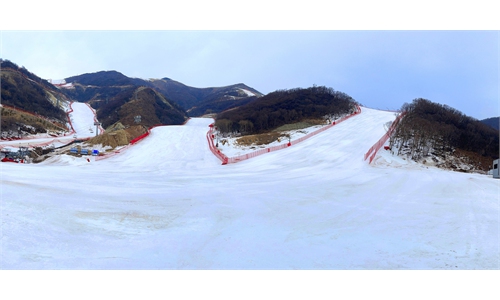
Chinese skeleton athlete Yan Wengang wins the first-ever Olympic bronze medal for the country.Photo:VCG
Chinese skeleton athlete Yan Wengang won the first-ever Olympic bronze medal for the country in the adrenaline-pumping sliding sport. One cannot turn a blind eye to the indispensable help of the country's scientific and research efforts and the use of 3D technology behind his win.
Yan collected the country's first medal in a sliding sport by winning bronze with a total time of 4:01.77 after the fourth run, following Christopher Grotheer (4:01.01) and Axel Jungk's 4:01.67, both from Germany, after Friday's competition at Yanqing National Sliding Centre in Beijing.
"I was full of confidence and showed my best in this competition," Yan said in an interview after Friday's win.
The sport requires athletes to begin a 25-meter long running start before lying prone on the vehicle and sliding down the track. And the explosiveness of short run is key to the success of the whole competition, as the athletes' run-up will boost the speed of their sled as well.
"The run-up at the beginning is in fact a very important technique for athletes. For example, if one athlete runs faster by 0.1 seconds at the beginning's run-up, he or she would be sliding even faster by 0.3 seconds in the end," Gao Binghong, dean of Training and Education School at Shanghai University of Sport, told The Paper.
In order to enhance the force, Chinese skeleton athletes' shoes are installed with 258 titanium alloy studs on the sole achieved through 3D printing technology, said the report on Saturday.
And the alloy studs on the shoes, made specially for hinges skeleton athletes, were introduced by the Chinese sportswear brand Anta, said Fujian Daily.
In addition, the athlete's uniforms were also made based on the proportion of each team member's muscle lines through 3D printing technology, which can maximize the athlete's power during the competition, said the report.
Skeleton has a long history as an Olympic sport. It was first contested at the 1928 Switzerland WinterOlympics. China, however, is still at the early stage of developing the sport as the country's skeleton team wasn't established until 2015.
After his win, Yan said in an interview that he hoped more athletes can join "this niche program."
"Everyone thinks that skeleton is dangerous, but in fact, it is not dangerous after professional training and on the contrary one can really enjoy the sport," Yan said.
Global Times



